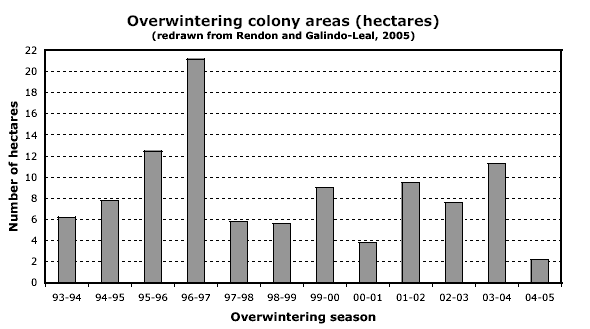
|
An estimated 2.19 hectares were occupied by Monarchs (Fig. 1)
in the Monarch Sanctuary Butterfly Reserve
during the winter of 2004-2005.
The actual number of Monarchs per hectare is not known, but estimates range from
10 to 50 million. (1 hectare = 2.47 acres)
There has been much discussion of this historically low number
of overwintering Monarch butterflies in Mexico
in both the popular press, such as on the
front page of the Washington Post and in the scientific community:
The Informally Constituted Monarch Butterfly Scientific
Advisory Committee (ICMBSAC). 17 February 2005.
Reduced numbers of monarch butterflies overwintering in Mexico during the
2004-2005 season: evidence, possible causes and recommendations.
http://www.monarchwatch.org/update/2005/0221_Sci_Adv_Rpt_11.pdf
Figure 1.

|
Rendon-Salinas, E. & Galindo-Leal, C. 2005. Monitoreo de
las colonias de hibernacIon de la mariposa monarca,
Diciembre 2004: reporte preliminar. World Wildlife Fund-Programa Mexico, Mexico
City. pp. 1-9.
While a mere 2.19 ha of occupied Monarch habitat is extremely
disconcerting, if we use the end of winter
(post-freeze) population estimates, Monarchs only occupied less than 4 ha at the end
of 4 of the last 5 winters.
A severe storm also occurred on 2-3 March 2000 (discussed in Taylor, 2001) killing
an unknown number of Monarchs.
If we include this storm, then the end of winter Monarch population probably
occupied less than 5 ha in 7 out of 8 years. (Fig. 2)
Taylor, O.R. 2001. What happened last winter? Monarch Watch 2000 Season Summary. pp. 16-17, 54.
Miraculously, these freezes all occurred during years of
average to above average Monarch populations.
Another point to note is that the Monarch population increased substantially
over six of the last ten summers,
and more than tripled following the previous historically low populations
of 00/01 and 01/02.
Heavy rains followed by a freeze are the worst case scenario as
Monarchs have a very low tolerance to freezing temperatures when wet.
Monarchs are usually spared heavy winter rains as they
form their colonies during Mexico's dry season.
Figure 2.
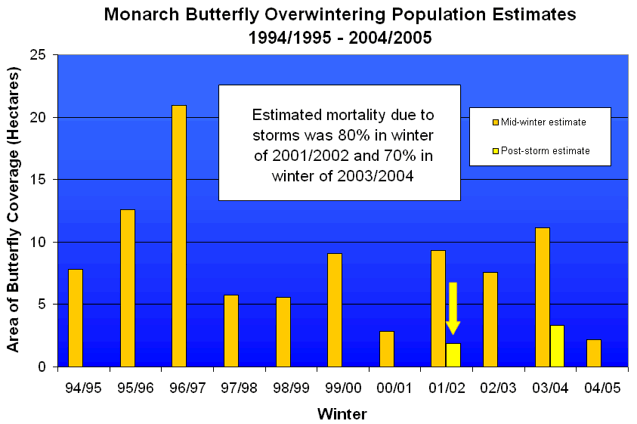
|
Monarch Migration Update: March 4, 2005
How Many Monarchs? Before or After the Long Winter?

Given that the Monarchs increased substantially from their
previous historical low winter populations of 00/01 and 01/02,
why didn't the monarchs similarly recover from the post-freeze low of the 03/04 winter?
One possible contributing factor to the non-recovery is the ever increasing
percentage of
Bt and herbicide tolerant biotech crops, particularly corn and
soybeans.
Wassenaar & Hobson (1998) determined through their study
of the isotopes of overwintering Monarchs
and of milkweed plants from across eastern North America, that the Monarch overwintering colonies
in Mexico
were composed of individuals that migrated mainly from the Midwestern United States
(Fig. 3).
During the fall migration, Monarchs form nightly communal roosts
that are reported to
and mapped by Journey
North (Fig. 4) that originate in the Midwest.
Texas Monarch Watch, Texas
Parks & Wildlife, refers
to their main passage through Texas as the "Central Flyway."
| Figure 3. | Figure 4. | |||
|
|
|||
|
(link) |
||||
| The light-gray area indicates the range of natal origins for 95% of overwintering monarchs. The darker-gray area indicates range of natal origins for 50% of the ow monarchs. |
Monarch
Communal Roost Sites |
Hobson, K.A., L.I. Wassenaar & O.R. Taylor. 1999. Stable isotopes (δ2H and δ13C) are geographic indicators of natal origins of monarch butterflies in eastern North America. Oecologia 120:397-404.
Wassenaar, L.I. & Hobson, K.A. 1998. Natal origins of migratory monarch butterflies at wintering colonies in Mexico: new isotopic evidence. Proceedings of the National Academy of Sciences USA, 95, 15436-15439.
The origins of Monarchs are perhaps best demonstrated from tags placed on their wings that are subsequently recovered at the overwintering sites in Mexico. Monarch Watch Organization, University of Kansas, runs the tagging program for the eastern United States. In December 1998, Chip Taylor, Director of Monarch Watch, decided to offer a reward of 50 pesos (~$5 US) for each tag recovered in Mexico (Taylor, 1999). The number of tags recovered increased dramatically as word of the reward quickly spread (Table 1). Prior to offering a reward, Monarch Watch annually recovered 10-15 tags in Mexico (Taylor, 1999).
After the storms and subsequent freezes of 2-3 March 2000 and 12-13 January 2002, Monarch Watch severely strained to pay for some 698 and 1790 recovered tags (respectively). (Read about Monarch Watch's Tag Recovery Fund, Monarch Watch Update - January 14, 2005.)
Table 1.
| Year Tagged |
Approximate |
||
| 1957-1997 | 147 | ||
| 1998 | 399 | ||
| 1999 | 689 | ||
| 2000 | 229 | ||
| 2001 | 1790 | ||
*These numbers are approximate as tags from these years are still being turned in.
|
|
||||||||
The above map, like the isotope study and communal roost map,
indicates that the origin of
Mexico's overwintering Monarchs is primarily from the Midwestern United States.
Monarch Watch 2001 Season Recoveries
Dave Kust. 2002. Migrating with the Monarchs. Pp: 14-15. in: O.R. Taylor (ed). Monarch Watch 2001 Season Summary.
Taylor, O.R. 1999. Introduction. Monarch Watch 1998 Season Summary 7(1):3.
Taylor, O.R. 2002. 2001 Monarch Recovery Maps. Origins of Tagged Monarchs Recovered in Mexico. Monarch Watch 2001 Season Summary pg. 18.
The natal origins of the Mexico overwintering Monarchs overlap with what is known as the cornbelt which is illustrated here:
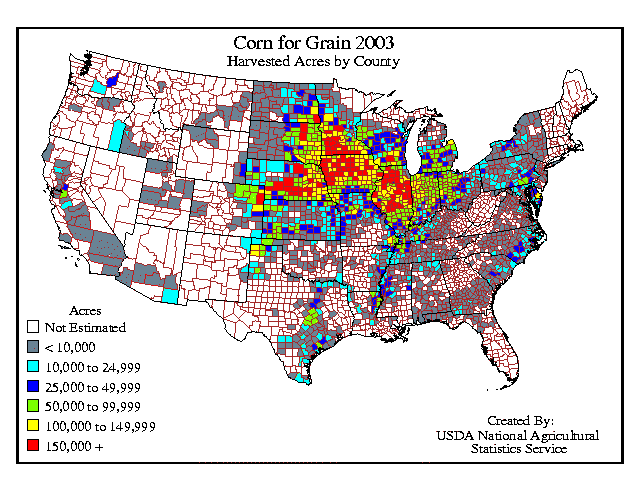
The natal Monarch origins are also in the heart of the soybean patch:
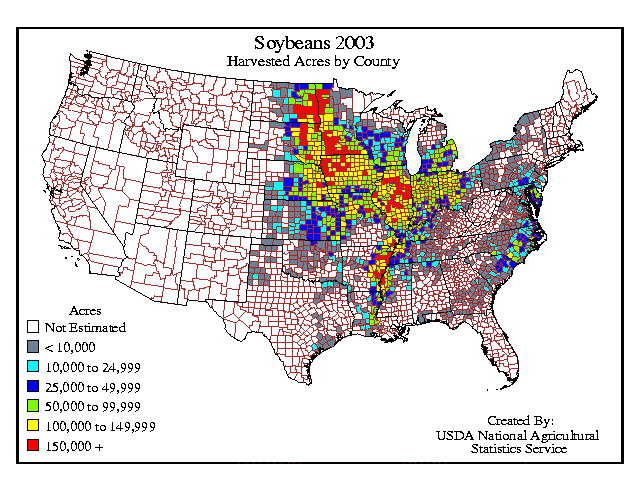
Both corn and soybeans are rapidly being converted from
traditional plants to plants that are genetically modified.
Corn is being converted to Bt Corn which gives the plants insecticidal
properties that effect caterpillars that feed on it.
Over 80% of the soybeans planted in the U.S. last year were genetically modified
to be herbicide tolerant
The potential dangers of Bt corn made world news on May 20,
1999 when Cornell University researchers published a paper
(Losey, et al. 1999) demonstrating that the pollen from Bt corn could
harm monarch larvae under laboratory conditions.
The extreme amount of attention that this issue received caused an immediate drop in the acreage of Bt corn (Fig. 5).
Losey, J.E., Rayor, L.S., Carter, M.E. 1999. Transgenic pollen harms monarch larvae. Nature 399:214.
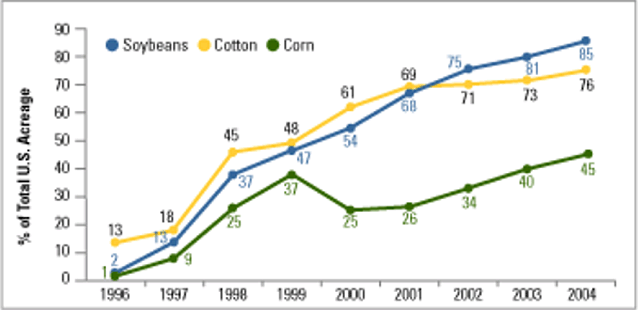
The potential dangers of Bt corn demonstrated by the
Losey, et al. (1999) paper also induced
much new field research on the monarch, milkweed, and Bt corn.
Hartzler and Buhler (2000) looked at where common milkweed was growing in Iowa. Abstract:
| Interest in the population dynamics and geographic distribution of common milkweed (Asclepias syriaca L.) has recently increased due to the importance of common milkweed in the life cycle of the monarch butterfly (Danaus plexippus). A survey of common milkweed occurrence in various habitats was conducted in Iowa in June and July of 1999. Common milkweed was found in 71% of the roadsides and approximately 50% of the corn (Zea mays L.) and soybean (Glycine max L. Merr.) fields. Corn and soybean fields had 85% fewer patches than roadsides. Conservation reserve program fields had the greatest average area infested. While common milkweed was frequently found in corn and soybean fields, average frequency and patch sizes were much greater in noncrop areas. |
Hartzler, R. G. and D. D. Buhler. 2000. Occurrence of common milkweed (Asclepias syriaca) in cropland and adjacent areas. Crop Protection 19:363-366.
Taylor and Shields (2000b) looked at how much land was suitable for milkweed and hense monarch caterpillars. Excerpt:
|
This study provides a geographic information system (GIS) based assessment of the effective breeding habitat for the summer generations. We estimate that for the 95% breeding area 65.1% or 2.25 million km2 constitute milkweed/Monarch habitat. If Canada were included in our figures, the total effective breeding area would be 2.50 million km2 of Monarch butterflies in eastern North America. Suitable Monarch habitats were considered to be any open habitats which appeared to have the potential to sustain milkweed populations. In fact, much of the "suitable habitat" contains little or no milkweed. The landcover classification shows that many of the suitable habitats are intensely managed (e.g., alfalfa) and probably lack milkweed. At this point, because there are no surveys for milkweed abundance across all of the landcover types, we can only speculate how much of the "suitable habitat" is actually populated with milkweed plants. We estimate that 60% of this suitable or effective breeding habitat contains milkweed. If this is true and we use 2.5 million km2 as the effective breeding habitat for eastern North America, then 1.5 million km2 (370.6 million acres) account for the Monarch productivity each season. |
Taylor, O.R. and J. Shields. 2000a. The summer breeding habitat of monarch butterflies in eastern North America. Unpublished report prepared for the Environmental Protection Agency, Washington, DC. 52 pp.
Taylor, O.R. and J. Shields. 2000b. What constitutes Monarch summer breeding habitat and how much of this habitat occurs east of the Rockies? Monarch Watch, 1999 Season Summary 8:12-16.
Sears, et al. (2001) looked at the effect of Bt corn on monarch larvae. Excerpt:
| The corn hybrids currently registered "have little or no effect on monarch populations, although sublethal effects due to chronic exposure to Bt pollen over the entire larval growth of monarchs has not been accounted for in these studies. Should chronic effects he documented, the impact on monarch populations will remain low or negligible, because overall exposure of monarch larvae to Bt pollen is low." |
Sears, M.K., R.L. Hellmich, D.E. Stanley-Horn, K.S. Oberhauser, J.M. Pleasants, H.R. Mattila, B.D. Siegfried, and G.P. Dively. 2001. Impact of Bt corn pollen on monarch butterfly populations: A risk assessment. Proc. Natl. Acad. Sci. 98(21):11937-11942. [PDF]
As a result of the
Now some scientists (ICMBSAC, 2005) think that genetically engineered soybeans are the threat to monarchs, not GE corn:
| "Adoption of soybean, and to a lesser extent corn, that has been genetically engineered to be resistant to herbicides has been widespread. Herbicides are sprayed in early spring, killing virtually all other emerging plants including A. syriaca and myriad potential nectar resources. ... The scale of this emerging problem is enormous, but as yet unquantified." (ICMBSAC, 2005) |
More research is needed to shed light on this issue, but note
that the monarch population tripled over the summers of 2001 and 2002
and increased significantly over the summer of 2003 (Fig. 2) at a time when the
percentage of genetically modified
(herbicide tolerant) soybeans were 68, 75, and 85% respectively (Fig. 5).
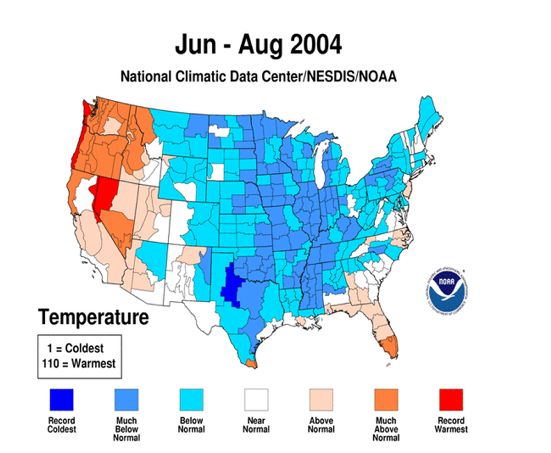
|
Interestingly, the weather conditions of the summer of 2004 were most conducive to crop growth (Changnon & Changnon. 2005).
Changnon & Changnon. 2005 Abstract:
| Weather during the 2004 growing season in the Midwest, along with improved plant genetics and farming practices, produced exceptionally high yields of all major crops with resulting record yields 10 to 25 percent above prior records, an exceptional increase. [example] Record corn and soybean yields in Illinois and five other states had profound effects on crop prices, etc. Crop experts, regional farmers, and crop-weather models failed to detect and predict the enormous magnitude of the final yields. This inability to assess the magnitude of the 2004 crop yields likely resulted from a lack of information about the presence and effect of the frequent days with clear skies in 2004. The number of clear days, 50 percent to 105 percent above average across the entire Midwest, also were accompanied by much below average temperatures and normal rainfall. Examination of Illinois climate conditions over the past 117 years reveals that when many clear days occurred, most summers were quite hot and dry. Only one prior summer (1927) had comparable conditions to those in 2004. Summer 2004 weather conditions also were unusual in other respects, including having characteristics that were beneficial for all crops. For example, prior record high yields occurred in 2003 for corn, in 1994 for soybeans, in 2001 for sorghum, and in 1990 for alfalfa. Seldom does the entire Midwest experience near uniform summer weather conditions, reflecting another climatologically-unique aspect of summer 2004 weather. Canadian high-pressure centers, resulting from the intrusion of 20 strong cold fronts, frequently dominated the atmospheric circulation across the central United States during the summer, limiting the movement of warm, moist air into the region and creating the seasonís high frequency of clear days. |
Changnon, S.A, & D. Changnon. 2005. Unique 2004 Growing Season Weather Conditions Resulting in Record High Crop Yields in Illinois and the Midwest. Illinois State Water Survey, Champaign, IL. 24 pp.
Chip Taylor and Janis Lentz, of Weslaco East High School, (2005) wrote an article discussing the effects of the summer of 2004 on the monarchs and speculate about the "Year Without a Summer"...
Taylor, C. & J. Lentz. January 14, 2005 Update, Teaching with Monarchs: Monarchs, Cold Summers, Jet Streams, Volcanoes, and More.
25 Mar 2005 © Mike Quinn / mike.quinn@tpwd.state.tx.us / Texas Entomology / Texas Monarch Watch